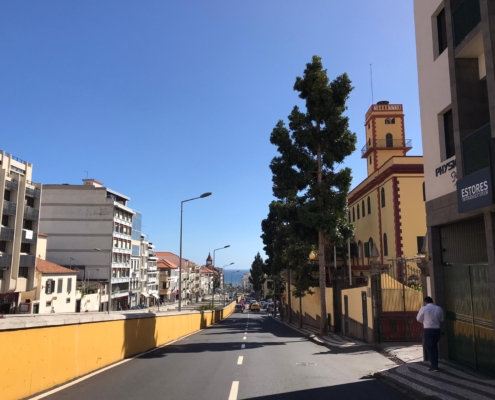Rua 5 de Outubro
This is one of the longest streets in Funchal, about 1972 metres long, stretching from Avenida do Mar e das Comunidades Madeirenses in the south to Rotunda dos Viveiros in the north. It runs parallel to the Ribeira de Santa Luzia and is only open to traffic in a downward direction.
Until the end of the Monarchy in our country, this street had the designation of Rua do Príncipe, but with the Implantation of the Portuguese Republic on the 5th October 1910, it was changed to the name we know today.
Going up, at the crossroads with Rua do Bettencourt, you will find the emblematic Bazar do Povo, founded in 1883, which from its golden times we remember its commercial importance in the city, where there was the “Secção de Fotografia” and where the albums “Souvenirs of Madeira” were edited, and which existed until the 60s of the 20th century. Nowadays and with the same external appearance, it is a Chinese commercial space.
A few meters above, on the corner with Travessa, do Forno, you can find the century-old Fábrica de Santo António, classified as a shop with history, and known for making biscuits that are highly preferred by the local population and responsible for the sweet tooth aroma that we can feel in its surroundings.
Passing by the Loja do Munícipe, where you can deal with any matter related to the Municipal Council, you will find the Madeira Wine and Embroidery Institute, created in 1979 to discipline the production and trade of Madeira wine.
There is a wide range of services to be found on this rise, including commercial shops, pharmacies and numerous residential flats. Almost at the end of the street is Luz Hospital (formerly Santa Catarina Clinic),
Curiously, this street is connected to ten bridges, three of which are pedestrian-only. In the upward direction, we find the exclusively pedestrian bridges, namely Ponte do Cidrão, Ponte D. Manuel and Ponte do Nacional, recently built and inaugurated at the end of 2020, to connect the southern part of Rua dos Ferreiros to Rua Direita.
As road bridges, and also in an upward direction, we find the Bettencourt Bridge, Nau Sem Rumo Bridge, Bom Jesus Bridge, Nova Bridge, Santa Emília Bridge, Torreão Bridge, Saúde Bridge, Til Bridge, Pau Bridge and Rampa dos Viveiros Bridge.







